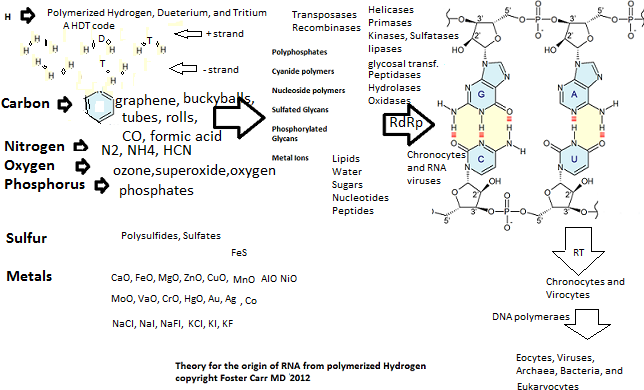
Framework : Procells to Precells

ProCells:
Coacervates arose prior to Precells. They are the first cyclical metabolic systems and evolved with solar system collisions. Formic Acid and Cyanide provided the raw material for polymerized byproducts. While Phosphate, Zinc, Magnesium, Copper,Molybdenum, Sulfur and Iron influenced the choice of metabolic pathways.
Precells evolved from Coacervates based ProCells after further accretions of early solar system bodies.
1. Proteinocytes/ Proteoids were the first life forms to replicate through non ribosome protein synthesis. They encapsulized the coacervates/ proteinoid microspheres with pseudomurein. and may have evolved from Buckyballs containing Polymerized Hydrogen and Metal Atoms.
Examples of Proteinocytes include :
Bacterial Vesicles / Organelles- Potential PreCellular Life Forms
Magnetosomes
Chromatophores
Thylakoids
Chlorosomes
Polyphosphate granules/Volutin granules/acidocalcisomes
Elements involved in the biogenesis of these vesicles include: vacuolar proton pyrophasphatase AP-3, and rab 11, polyP kinases (ppks), polyP-dependent glucokinases (ppgks), phosphate transporters (pits), ppx gene for exopolyphosphatase, phaABC genes polyP kinases (ppks), two polyP-dependent glucokinases (ppgks)for PHA synthesis , actP gene for acetate/H+ symporter.
Unusual polyphosphate inclusions observed in a marine Beggiatoa strain
Deciphering the Genome of Polyphosphate Accumulating Actinobacterium Microlunatus phosphovorus
Mg, Ca, Strontium, and Barium Carbonate Nanoballs in Cyanobacteria
hypothesized functions:
1. Protection from Gamma , Xrays, and UV radiation ? contain RNA or DNA
2. Photosynthesis using Gamma Rays and Xrays
3. Motility Organelle : ie. Balasts for positioning in the hydrological goldilox zone
4. Chemolithotrophy involving free radical oxygen.
5. Organization of the formative electron transport chain
6. Storage of Carbon, Oxygen, and Hydrogen for macromolecular biosynthesis.
7. Chemosensory organ
Nitrate Vacuoles
Vacuolated Beggiatoa-like filaments from different hypersaline environments form a novel genus.
Secretin Structures
Secretins: dynamic channels for protein transport across membranes
Sulfur Granules
Gas Vacuoles
Pre-contractile Vacuole
Carboxysomes
Bicarbonate producing Organelles
Endoliposomes
Secreted membrane vesicles
Evolution of diverse cell division and vesicle formation systems in Archaea.
2. Inteinocytes are PreRNA based Proteinocytes and replicate through non ribososme protein synthesis. Inteinocytes contain self and non self splicing inteins. They have not yet evolved messenger RNAs but have Ribozymes, Riboswitches, Group I and II Introns, pretRNAs , preRibosomal RNAs, and other non coding RNAs.
3. Transpocytes are RNA based proteinocytes. They have a peptidyl transfer system that utilizes RNA ligation and polymerization enzymes, polyketide synthesis, nonribosomal peptide synthetases, and ubiquitin conjugation systems .. The ribosomal system is still evoling along with RNA replication/transcription systems.
RNA transpocytes are inteinocytes with replicative RNA
DNA transpocytes are inteinocytes with replicative RNA and DNA
4. Chronocytes/Virocytes are transpocytes with lipid membranes and transitional RNA/DNA genetic storage systems. They Operate with specific operons for hyperthermophilic, mesophilic, and psychrophilic environments. Their genomes are primarly RNA based.
5. Eocytes containing DNA and multiple types of membranes gave rise to Prokaryotes and followed by Eukaryocytes. They were Possibly delivered to early Earth during the Theia impact and the late heavy bombardment. They may also have been present on other solar system bodies.
References:
The formation of vault-tubes: a dynamic interaction between vaults and vault PARP
Hydrogen cyanide polymers, comets and the origin of life.
Structural Analysis of CsoS1A and the Protein Shell of the Halothiobacillus neapolitanus Carboxysome
©2012 -2013Foster P. Carr MD all rights reserved